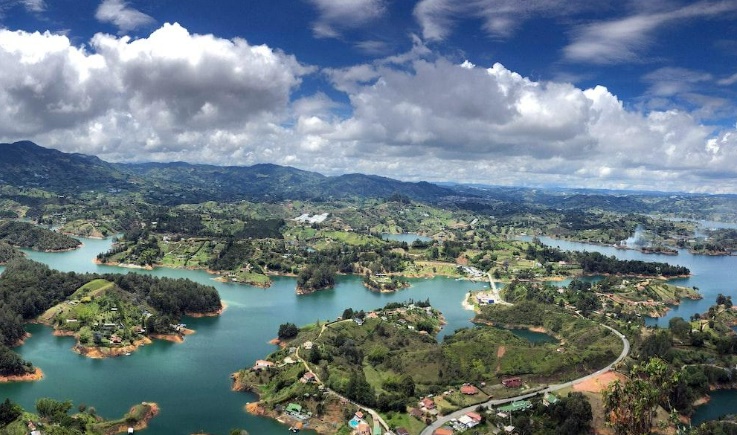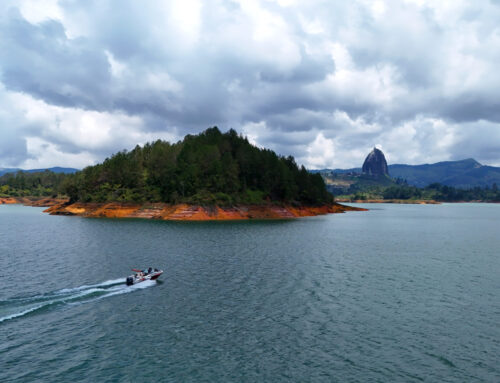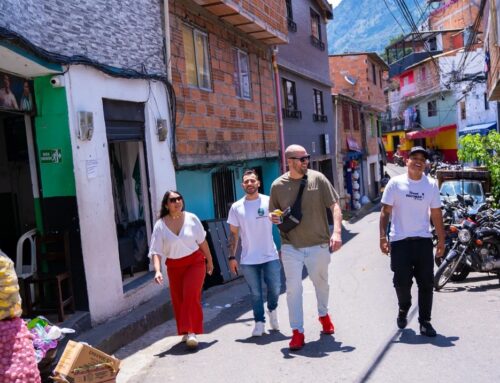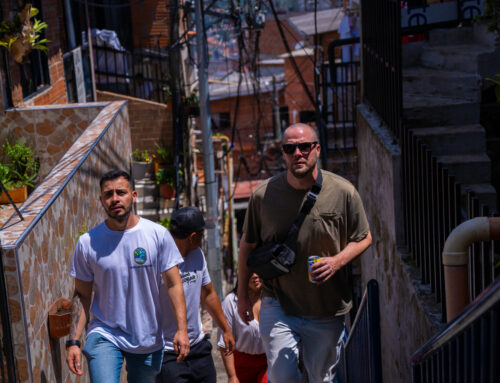
Today, Guatape is known as a colorful tourist destination that’s located just a couple of hours away from Medellin. However, this is a far cry from what it was like just a few decades ago. It was a tourist destination then as well, but it spent most of the year quiet and empty of visitors. So what changed to turn Guatape into a thriving town that’s visited by hundreds of thousands of people every year? This transformation can mainly be attributed to the building of the Guatape hydroelectric plant in the 70s, a development that’s had both positive and negative effects on the area.
Guatape before the hydroelectric plant
Prior to the 1970s, Guatape’s main economic driver was agriculture. The region was known for crops like potatoes, corn, carrots, and beans, and the Negro-Nare river that passed near the town was a steady source of fish as well. The current town center has occupied the same spot for many decades, but many of Guatape’s rural inhabitants lived in the adjacent mountains and valleys.
Tourism played a part in the town’s economy, but only a small one. One of the main draws for visitors was Guatape’s Rock – El Peñón de Guatape, a massive rock outcropping that measures around 665 feet tall. In the 50s, a man named Luis Eduardo Villegas Lopez bought the rock and built stairs to the top, making it possible for tourists to scale it without the need for climbing equipment or experience.
Another key attraction for the small numbers of tourists were the colorful houses that Guatape is still famous for. These houses are painted in bright colors, and decorated with personalized motifs that represent the occupations or passions of the owners.
The building of the Guatape hydroelectric plant
In a way, the hydroelectric plant that was built in the 70s actually got its start in the 30s. This was when Medellin was becoming a bustling urban center, requiring increasing amounts of natural resources like water. One newspaper at the time estimated that within the next 50 years, the city would be out of water and would have to relocate from the Aburra Valley.
This prompted technicians and engineers in the city to look for alternative sources of water, and Negro-Nare River presented itself as a potential solution. In 1955, the Empresas Publicas de Medellin (EPM) became the region’s main provider of utilities like electricity, telephone services, and water. From the beginning, they pushed for the city’s water supply to be expanded; this led to inspections to determine the suitability for a hydroelectric project in Guatape.
By the late 1960s, EPM had decided to go ahead with the project, but it hadn’t yet calculated how flooding the entire valley would affect the people who lived there. Guatape’s rural residents would have to relocate, as well as the entire town of El Peñol (which is now located at the edge of the manmade lake). Protests were mounted, resulting in a “Contrato Maestro” with 95 clauses that required EPM to mitigate the impact of the flooding on local residents. Unfortunately, almost all of these clauses ended up being ignored, and further protests were unsuccessful.
The flooding of the reservoir didn’t take place all at once; it actually happened gradually between 1970 and 1979. Even though it meant the forced resettlement of indigenous populations, it also brought wealth and tourism to the region in the decades that followed.
For many residents, the current situation is bittersweet. On the one hand, they have more economic opportunities now than ever before, in industries that will keep going strong for decades to come. On the other hand, they can look out on Lake Guatape and see the tower of El Peñol’s flooded church rising out of the water; they also remember the stories from older generations, about how they had to flee with whatever they could carry as the waters rose around their ankles. As with many transformation stories, the history of Guatape isn’t a completely happy one. That being said, the benefits of the hydroelectric plant have extended to the entire Antioquia region and beyond, providing crucial utilities for people all over Colombia. They’ve even had a positive effect on tourism in Guatape, since the manmade lake is now an iconic part of the landscape.
What Guatape is known for today
Rather than being the agrarian community of a few decades ago, Guatape is now mainly known as a tourist attraction. Since it’s so small, most visitors only stay for a couple of days at most; in fact, some tourists arrive from Medellin for a quick day trip. These are some of the top activities in Guatape.
Glamping
Glamping in Guatape has become extremely trendy, and for obvious reasons. The scenery is spectacular. There are a ton of water-related activities to do and an amazing and vibrant town to explore!
Some of the glamping locations in Guatape are fully equipped with kitchens, boats, chefs – you name it! From price conscious consumers, to those that want to go all out for a special event or a once-in-a-lifetime vacation, glamping in Guatape is highly recommended!
Water-based sports
Guatape sits right on the edge of Guatape Lake, and you can be sure that there are countless services available for tourists who want to enjoy the water. These include boat rentals, kayaking, jet skiing, guided lake Guatape tours, and more.
El Peñón de Guatape (Piedra del Peñón)
This is by far the most striking feature of the landscape, and tourists have been coming to visit El Peñón de Guatape since the 50s. Not only has a staircase been added, but there are also vendors along the 700+ steps to the top, as well as more at the peak of the rock. Visitors get to enjoy stunning 360-degree views of the surrounding countryside, plus the archipelago of Guatape Lake.
Adventure sports
Anyone who likes high-adrenaline sports can choose from a variety of activities. These include ziplining, biking down a mountain, hiking local trails, paragliding over nearby mountains, or rappelling down a waterfall.
Exploring Guatape
Even though the town itself is quite small, it still offers enough activities to keep you entertained for a few hours. There are quaint cafes and restaurants, vendors selling quality hand-made items, and Guatape’s famously colorful houses that attract photographers from all over the world.
The history of Guatape is one of rebirth and transformation
Just like many other Colombian cities, Guatape has been through some hard times. However, it’s also managed to reinvent itself over the past few decades, becoming one of the top tourist destinations in the region.




